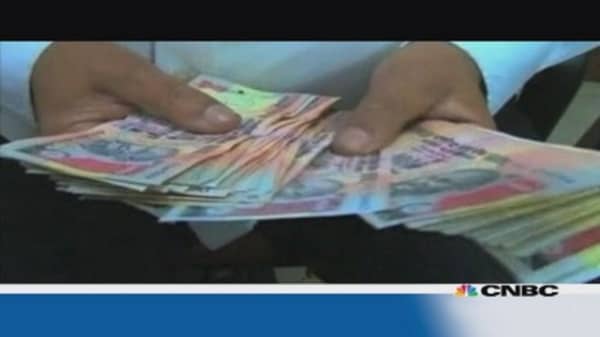"It looks like the rupee is in a new uncharted territory. A next key level is 70.00, but the 70.00 is just a psychological level (not a technical one)."
With technical analysis not offering much guidance, investors are looking even more closely at forwards and futures markets, which can be an excellent gauge of price expectations.
These markets suggest the rupee - despite being down 18 percent against the dollar this year and recently hitting a record low of 68.85 - could fall further yet.
There are both onshore forwards and futures markets and offshore NDF markets for the rupee, with trade in the latter taking place in Singapore, Hong Kong, New York and London, unfettered by Indian central bank regulations that control the onshore market.
Rates in the onshore futures market have the rupee at 67.06 in one-month, versus a spot rate of 66.55. Three-month rates are quoted at 68.40, six-month at 69.24 and 12-month at 70.80.
(Read more: Why the rupee may not be headed to 70)
Quotes in the offshore NDF market are also bearish. One-month rupee NDFs are trading at 67.49, while the three-month is at 68.74, the six-month at 70.05 and the 12-month at 72.34.
The difference between the onshore and offshore quotes reflects the different players that are active in each market. While traditionally the NDF market has been the home of offshore speculators - and still is given the pressure the rupee is under - it is also home to genuine hedging now that so many restrictions have been imposed onshore.
Indian regulators have taken steps to reduce arbitrage opportunities between the onshore and offshore markets because they believe that speculation in these markets puts pressure on the spot rate.
The NDF market has influenced India's foreign exchange market but more so has influenced volatility, outgoing Reserve Bank of India governor Duvvuri Subbarao said after his monetary policy review on July 30. "It will be a better world for us if there is no NDF market, but we cannot wish it away."
(Read more: Are the stars not aligned for the rupee?)
Onshore spot traders in Mumbai agree, saying that the severe bearish bets against the rupee in the offshore markets had a negative impact on the rupee's opening trades on days when other Asian currencies were relatively stable.
"We are seeing the NDF markets having a big impact on the rupee's fortunes during the current bout of depreciation. It is complicating the RBI's rupee defence as it does not have any regulatory purview over the market," said Subramanian Sharma, director at Greenback Forex.
The RBI has tried to make speculating on the rupee expensive. Among a wide range of measures the most acute has been to raise short-term interest rates, which have spiked by almost 300 basis points, roiling bond markets and raising the cost of funds for banks and companies looking to short the rupee - as well as inducing a rupee credit squeeze.


.530x298.jpg?v=1377844574)


